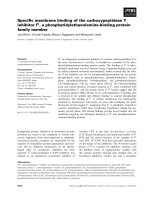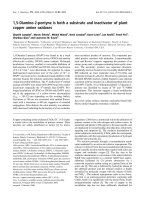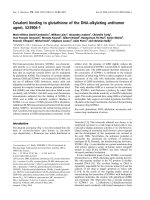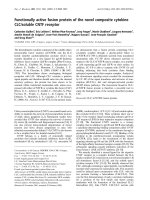Báo cáo khoa học: "Soft tissue non-Hodgkin lymphoma of shoulder in a HIV patient: a report of a case and review of the literature" pps
Bạn đang xem bản rút gọn của tài liệu. Xem và tải ngay bản đầy đủ của tài liệu tại đây (610.43 KB, 6 trang )
BioMed Central
Page 1 of 6
(page number not for citation purposes)
World Journal of Surgical Oncology
Open Access
Case report
Soft tissue non-Hodgkin lymphoma of shoulder in a HIV patient: a
report of a case and review of the literature
Domenico Marotta*
1
, Alessandro Sgambato
2
, Simone Cerciello
1
,
Nicola Magarelli
3
, Maurizio Martini
4
, Luigi Maria Larocca
4
and
Giulio Maccauro
1
Address:
1
Department of Orthopedics and Traumatology, Università Cattolica del Sacro Cuore, Rome – Italy,
2
"Giovanni XXIII" Cancer Research
Center – Università Cattolica del Sacro Cuore, Rome – Italy,
3
Department of Radiology, Università Cattolica del Sacro Cuore, Rome – Italy and
4
Department of Pathology, Università Cattolica del Sacro Cuore, Rome – Italy
Email: Domenico Marotta* - ; Alessandro Sgambato - ;
Simone Cerciello - ; Nicola Magarelli - ; Maurizio Martini - ;
Luigi Maria Larocca - ; Giulio Maccauro -
* Corresponding author
Abstract
Background: The risk of developing lymphoma is greatly increased in HIV infection.
Musculoskeletal manifestations of the human immunodeficiency virus (HIV) are common and are
sometimes the initial presentation of the disease. Muscle, bone, and joints are involved by septic
arthritis, myopathies and neoplasms. HIV-related neoplastic processes that affect the
musculoskeletal system include Kaposi's sarcoma and non-Hodgkin's lymphoma, the latter being
mainly localized at lower extremities, spine and skull.
Case presentation: The Authors report a case of a 34 year-old lady. In December 2003 the
patient noted a painless mass on her right shoulder whose size increased progressively. In March
2004 she was diagnosed HIV positive and contemporary got pregnant. The patient decided to
continue her pregnancy and to not undergo any diagnostic procedure and treatment. At the end
of August she underwent a surgical ablation of the lesion that revealed a lesion of 7 cm × 7 cm ×
3,3 cm. The histology showed B-cells expressing CD20, PAX-5, CD10, BCL-6 and MUM-1 with
70% Ki67 positive nuclei. The lesion was also negative for EBV infection and showed a monoclonal
rearrangement of IgH chain and a polyclonal pattern for TCR gamma and beta. A final diagnosis of
diffuse large B-cell lymphoma was made. The patient underwent postoperative chemotherapy. At
four-years follow up the patient is symptom free and no local nor systemic recurrence of pathology
has been noted on MRI control. HIV infection is still under control.
Conclusion: In this report, we present a case of diffuse large B-cell lymphoma localized in the soft
tissue of the shoulder in a HIV infected patient. Authors want to underline this case for the rare
position, the big size and the association with HIV infection.
Published: 21 October 2008
World Journal of Surgical Oncology 2008, 6:111 doi:10.1186/1477-7819-6-111
Received: 31 March 2008
Accepted: 21 October 2008
This article is available from: />© 2008 Marotta et al; licensee BioMed Central Ltd.
This is an Open Access article distributed under the terms of the Creative Commons Attribution License ( />),
which permits unrestricted use, distribution, and reproduction in any medium, provided the original work is properly cited.
World Journal of Surgical Oncology 2008, 6:111 />Page 2 of 6
(page number not for citation purposes)
Background
The risk of developing lymphoma is greatly increased in
HIV infection which induces a severe impairment of the
immune system due to the progressive reduction of CD4
lymphocytes thus leading to the development of different
infections and tumors. The improvement of the therapy
with longer life expectancy has led to new associations
and, among these, the involvement of other tissues such
as the musculoskeletal system. Usually musculoskeletal
lesions involve lower limb. Authors report a rare case of
soft tissue lymphoma localized at right shoulder in a HIV-
infected patient.
Case presentation
A 37 years old lady (who was born in 1971) underwent a
surgical goldbladder ablation and a excision of appendici-
tis in 2001. Two years later, in December 2003 the patient
noted a painless mass on her right shoulder increasing
progressively with time. Her last menstrual cycle was
dated in November 2003. In March 2004 she was diag-
nosed with HIV and at the same time she started her preg-
nancy. At that time her blood count showed: WBC 6250,
lymphocytes 680, CD4 184 (27%) and CD8 354 (52%),
and analysis of HIV type 1 RNA detected 975 HIV RNA
copies/ml. Even if the lesion kept on growing fast, the
patient decided not to undergo any diagnostic procedure
nor any possible treatment until the end of pregnancy. In
the last period she suffered a mild diabetes, anyway in July
gave birth with no further problems. Then she performed
a MRI which showed, in T1W sequence, an homogeneous
isointense lesion in the posterolateral aspect of the right
shoulder below the deltoid muscle (Figure 1A). The TSE
sequence with deletion of the T2 signal from adipose tis-
sue showed a marked homogenous hyperintense signal.
The margins appeared clean and regular in the absence of
any evidence of infiltration, bone lesions and bone mar-
row involvement (Figure 1B).
At the end of August she underwent a surgical excision of
the lesion. The procedure was performed under general
anesthesia through a posterior incision. The split of the
deltoid fibers revealed a large lesion (7 cm × 7 cm × 3,3
cm) which was excised with free margins.
The histology showed a diffuse proliferation of large lym-
phoid cells with irregular round or oval nuclei. For immu-
nophenotypic studies the avidin-biotin-peroxidase
complex (ABC) method was performed on paraffin sec-
tions using a commercially available kit (Dako LSAB 2;
Dakopatts, Golstrup, Denmark) and the following com-
mercially available monoclonal antibodies: CD3, CD10,
CD20, PAX-5, BCL-6, CD138, MUM-1 and Ki67. EBV
infection was evaluated by in-situ hybridization of EBV-
encoded small RNAs (EBERs) on formalin-fixed, paraffin-
embedded tissue sections. In-situ hybridization analysis
was performed using a cocktail of fluorescein-isothiocy-
MRI images of the lesionFigure 1
MRI images of the lesion. A) Axial MRI performed with T1 gradient-eco sequence. B) TSE sequence with deletion of the T2
signal from adipose tissue.
World Journal of Surgical Oncology 2008, 6:111 />Page 3 of 6
(page number not for citation purposes)
anate-labeled oligonucleotides complementary to the
nuclear EBER RNAs, following the manufacturer's instruc-
tions (Dako; Dakopatts, Golstrup, Denmark), as previ-
ously described [1]. Neoplastic cells were CD20, PAX-5,
CD10, BCL-6, and MUM-1 positive with 70% Ki67 posi-
tive nuclei (Figure 2). EBV infection (in-situ hybridiza-
tion) was negative (data not shown) [1]. Molecular
analysis for clonal rearranged immunoglobulin (Ig) and
T-cell receptor (TCR) gamma and beta (performed follow-
ing the multiplex PCR assays and protocols of BIOMED-2
collaborative study) [2] showed a monoclonal rearrange-
ment of IgH chain (Figure 3) and a polyclonal pattern for
TCR gamma and beta (data not shown). A final diagnosis
of diffuse large cells B-lymphoma was made.
The patient underwent postoperative chemotherapy
according with CHOP (cyclophosphamide, doxorubicin,
vincristine, and prednisonesix) regimen. The split of the
deltoid muscle allowed a fast and complete range of
movement regain. After surgery patient also started HIV
treatment with a combination of Combivir (Lamivudine
plus Zidovudine) and Kaletra (Lopinavir/ritonavir). At
four years follow up the patient is symptom free and no
local or systemic recurrence has been noted; HIV infection
is still under control.
Discussion
HIV musculoskeletal manifestations are common and are
sometimes the initial presentation of the disease. Muscle,
bone, and joints are involved and could be affected by
infection (such as tuberculosis, pyogenic infection),
arthritis, myopathies, neoplasms and miscellaneous con-
ditions such as avascular necrosis and hypertrophic oste-
oarthropathy [3].
The association between HIV and lymphomas is relatively
common. The most frequent localizations are brain, lung,
tonsils and stomach followed by oral mucosa, neck, mus-
culoskeletal, subcutaneous and cutaneous tissues. In
about 70% of cases lymphomas are non-Hodgkin (NHL)
while only 30% are Hodgkin lymphomas [4,5]. The most
frequent histological types are diffuse large B-cell lym-
phoma (30–40%) and Burkitt's lymphoma (40–50%)
[4]. Unusual lymphoproliferative disorders associated
with HIV infection are: plasmablastic lymphoma, Castle-
man disease, EBV-associated lymphoproliferative disor-
ders, T-cell lymphoma and primary CNS lymphoma [6].
The incidence of NHL in HIV patients is 3% and lesions
are usually high grade and extra nodal [4,5]. Extranodal
NHL of soft tissues is a rare disease and is described in
only 0,1% of the cases [7]. Primary bone NHL in the
absence of extra skeletal disease has also been reported in
HIV patients, involves mainly the lower extremities, spine,
pelvis and skull and presents with fever, painful unilateral
limb swelling, weight loss and pathologic fracture [8,9].
Muscle lesions, generally associated with bone lesions, are
mainly described in the psoas muscle and at the lower
extremities [10,11]. Cutaneous B-cell lymphomas have
been also described in HIV patients as red skin nodules
mostly localized at arms, head and neck and trunk. These
lesions usually start from the skin and then involves the
underneath subcutaneous tissues without cutaneuos
ulceration and are usually smaller in size (max 5–7 mm)
[12,13] compared with the case reported in this study.
We report a lesion localized in the soft tissues of the
shoulder not involving the bone which is not typical in lit-
erature for both the position and the large size. To the best
of our knowledge, this is the only case in the literature of
such a lesion developed in a HIV patient. The mass grew
fast during the nine months of pregnancy that is the time
spent between the first clinical presentation and the surgi-
cal excision, because of the patient decision to not
undergo any diagnostic and therapeutic procedure before
delivery.
Different MRI appearances of primary muscle lymphomas
have been reported in the literature [14,15]. The mass may
appear hyper- or iso-intense on T1W images. Hosona et al
reported an homogeneous enhancement in two cases of
non-primary muscle lymphomas [16] while Beggs
reported six patients in which the mass appeared iso/min-
imally hyperintense on T1W and became hyperintense on
T2W with fat suppression sequences. Infiltration of the
subcutaneous fat was a typical feature in these cases [17].
The ultrasound and CT appearances of primary muscle
lymphomas are also generally non-specific and compati-
ble with neoplastic or inflammatory diseases [18].
HIV positive patients can develop pyomyositis, polimy-
ositis or muscle lymphomas which may be multifocal and
produce bright signals on T2-weighted sequences with fat
suppression [19,20]. Tehranzadeh et al. suggested that
MRI imaging is important for evaluating bone marrow
changes and characterizing adjacent soft-tissue involve-
ment [21]. Bone marrow changes are seen as areas of
hypointensity on T1-weighted images and as areas of
hyperintensity on STIR images or fat-saturated fast spin-
echo T2-weighted images. The associated soft-tissue mass
appears hyperintense on T2-weighted images. CT and
scintigraphy have a complementary role in evaluating
affected patients. Imaging findings are similar to those in
osteomyelitis, and clinical correlation is often needed.
The biopsy is necessary to define the diagnosis and should
be performed in HIV patients to exclude pyomyositis.
Surgery in soft tissue lymphoma is still controversial.
Damron et al. are convinced that lymphoma is a non sur-
gical disease in which chemotherapy and/or radiotherapy
World Journal of Surgical Oncology 2008, 6:111 />Page 4 of 6
(page number not for citation purposes)
Hematoxylin and eosin (A, B) staining of the lesion and representative immunostaining images (C-F)Figure 2
Hematoxylin and eosin (A, B) staining of the lesion and representative immunostaining images (C-F). Shown
are immunostatining examples of CD20 (C), Bcl-6 (D), PAX-5 (E) and CD10 (F). Original magnification: ×100 (A) and ×250 (B-
F).
World Journal of Surgical Oncology 2008, 6:111 />Page 5 of 6
(page number not for citation purposes)
are adequate therapeutic strategies and they do not recom-
mend the surgical excision since it would remove a clini-
cal barometer of responsiveness to medical treatment.
Biopsy should be only performed to confirm the nature of
the lesion, especially in differential diagnosis with soft tis-
sue sarcoma [22].
On the contrary Bozas et al. described a case of abdominal
wall mass (10 × 18 cm) situated between the abdominal
muscles and in which a wide excision was performed fol-
lowed by immuno-chemotherapy [23]. Belaabidia et al.
also described a case of muscle lymphoma of biceps fem-
oris (17 × 14 × 7 cm) in which treatment was wide surgery
followed by chemotherapy [24].
No other cases of soft tissue lymphomas of the shoulder
in HIV patients with dimensions compared to the one
reported in this study have ever been described in the lit-
erature. Because of the large dimension, Authors per-
formed an excision biopsy with tumor-free margins
followed by chemotherapy. This combined treatment was
expected to reduce the risk of local recurrences allowing
good functional recovery of the shoulder. Radiotherapy
alone without removing the mass was excluded for the
high risk of infection. Follow up have confirmed the
appropriateness of the treatment since the patient is still
disease-free after four years with good range of motion.
Conclusion
This study reports a very rare localization of a case of dif-
fuse large B-cell lymphoma in the soft tissue of the shoul-
der in a HIV infected patient. Excision biopsy followed by
chemotherapy allowed a good local and systemic control
of the disease with a good functional recover after four
years.
Consent
Written consent was obtained from the patient for publi-
cation of this case report.
Competing interests
The authors declare that they have no competing interests.
Authors' contributions
DM prepared the draft of case report. GM conceived the
idea of the case report and helped with the draft of it. AS,
SC and AD helped the draft of the case report. MM and
LMR performed the molecular analyses. NM performed
the radiological studies and helped with draft of case
report. All authors read and approved the final manu-
script.
References
1. Larocca LM, Capello D, Rinelli A, Nori S, Antinori A, Gloghini A, Cin-
golani A, Migliazza A, Saglio G, Cammilleri-Broet S, Raphael M, Car-
bone A, Gaidano G: The molecular and phenotypic profile of
primary central nervous system lymphoma identifies dis-
tinct categories of the disease and is consistent with histoge-
netic derivation from germinal center-related B cells. Blood
1998, 92:1011-1019.
2. Evans PA, Pott Ch, Groenen PJ, Salles G, Davi F, Berger F, Garcia JF,
van Krieken JH, Pals S, Kluin P, Schuuring E, Spaargaren M, Boone E,
González D, Martinez B, Villuendas R, Gameiro P, Diss TC, Mills K,
Morgan GJ, Carter GI, Milner BJ, Pearson D, Hummel M, Jung W, Ott
M, Canioni D, Beldjord K, Bastard C, Delfau-Larue MH, van Dongen
JJ, Molina TJ, Cabeçadas J: Significantly improved PCR-based
clonality testing in B-cell malignancies by use of multiple
immunoglobulin gene targets. Report of the BIOMED-2
Concerted Action BHM4-CT98-3936. Leukemia 2007,
21:207-14.
3. Biviji AA, Paiement GD, Steinbach LS: Musculoskeletal manifesta-
tions of human immunodeficiency virus infection. J Am Acad
Orthop Surg 2002, 10:312-20.
4. Besson C, Raphael M: Lymphoma genesis in the context of HIV
infection. Ann Med Interne (Paris) 2003, 154(8):523-8.
5. Cáceres W: Non-Hodgkin's lymphoma associated with the
acquired immunodeficiency syndrome. Bol Asoc Med P R 1995,
87(10–12):158.
6. Navarro WH, Kaplan LD: AIDS-related lymphoproliferatuve
disease. Blood 2006, 107:13-20.
7. Travis WD, Banks PM, Reiman HM: Primary extranodal soft tis-
sues Lymphoma of extremities. Am J Surg Pathol 1987,
11:359-366.
8. Wu CM, Davis F, Fishman EK: Musculoskeletal complications of
the patient with acquired immunodeficiency syndrome
Molecular analysis for IgH chain rearrangement (FR2 region)Figure 3
Molecular analysis for IgH chain rearrangement (FR2
region). A monoclonal pattern is evident in the analyzed
sample (Lane A) as well as in the control for a monoclonal
pattern (Raji cell line) (Lane D). Also shown are the negative
control (water) (Lane C), a control for a polyclonal pattern
(reactive lymphoadenitis)(Lane B) and the molecular weight
marker (Lane MW).
World Journal of Surgical Oncology 2008, 6:111 />Page 6 of 6
(page number not for citation purposes)
(AIDS): CT evaluation. Semin Ultrasound CT MR 1998,
19:200-208.
9. Aboulafia AJ, Khan F, Pankowsky D, Aboulafia : DMAIDS-associ-
ated secondary lymphoma of bone: a case report with review
of the literature. Am J Orthop 1998, 27(2):128-34.
10. Tehranzadeh J, O'Malley P, Rafii M: The spectrum of osteoarticu-
lar and soft tissue changes in patients with HIV infection. Crit
Rev Diagn Imaging 1996, 37:305-347.
11. Sipsas NV, Kontos A, Panayiotakopoulos GD, Androulaki A, Zorm-
pala A, Balafouta ME, Dounis E, Tsavaris N, Kordossis T: Extranodal
non-Hodgkin lymphoma presenting as a soft tissue mass in
the proximal femur in a HIV(+) patient. Leuk Lymphoma 2002,
43(12):2405-7.
12. Kiyohara T, Kumakiri M, Kobayashi H, Nakamura H, Ohkawara A:
Cutaneous marginal zone B-cell lymphoma: a case accompa-
nied by massive plasmacytoid cells. J Am Acad Dermatol 2003,
48(5 Suppl):S82-5.
13. Baldassano MF, Bailey EM, Ferry JA, Harris NL, Duncan LM: Cutane-
ous lymphoid hyperplasia and cutaneous marginal zone lym-
phoma: comparison of morphologic and immunophenotypic
features. Am J Surg Pathol 1999, 23(1):88-96.
14. Scally J, Garrett A: Primary extranodal lymphoma in muscle. Br
J Radiol 1989, 62(733):81.
15. Pilepich MV, Carter BL: Muscle enlargement in lymphoma
patients. Radiology 1980, 134(2):521-3.
16. Hosono M, Kobayashi H, Kotoura Y, Tsuboyama T, Tsutsui K, Koni-
shi J: Involvement of muscle by malignant lymphoma: MR and
CT appearances. J Comput Assist Tomogr 1995, 19(3):455-9.
17. Beggs I: Primary muscle lymphoma. Clin Radiol 1997,
52(3):203-12.
18. Biviji AA, Paiement GD, Steinbach LS: Musculoskeletal manifesta-
tions of human immunodeficiency virus infection. J Am Acad
Orthop Surg 2002, 10(5):312-20.
19. Major NM, Tehranzadeh J:
Musculoskeletal manifestations of
AIDS. Radiol Clin North Am 1997, 35(5):1167-89.
20. Steinbach LS: "MRI in the detection of malignant infiltration of
bone marrow" – commentary. AJR Am J Roentgenol 2007,
188(6):1443-5.
21. Tehranzadeh J, Ter-Oganesyan RR, Steinbach LS: Musculoskeletal
disorders associated with HIV infection and AIDS. Part II:
non-infectious musculoskeletal conditions. Skeletal Radiol 2004,
33(6):311-20.
22. Damron TA, Le MH, Rooney MT, Vermont A, Poiesz BJ: Lymphoma
presenting as a soft tissue mass. A soft tissue sarcoma simu-
lator. Clin Orthop Relat Res 1999:221-230.
23. Bozas G, Anagnostou D, Tassidou A, Moulopoulos LA, Bamias A,
Dimopoulos MA: Extranodal non-Hodgkin's lymphoma pre-
senting as an abdominal wall mass. Leuk Lymphoma 2006,
47(2):329-332.
24. Belaabidia B, Sellami S, Hamdaoui R, Essadki B: Primary malignant
non-Hodgkin skeletal muscle lymphoma: a case report. Rev
Chir Orthop Reparatrice Appar Mot 2002, 88(5):518-21.









